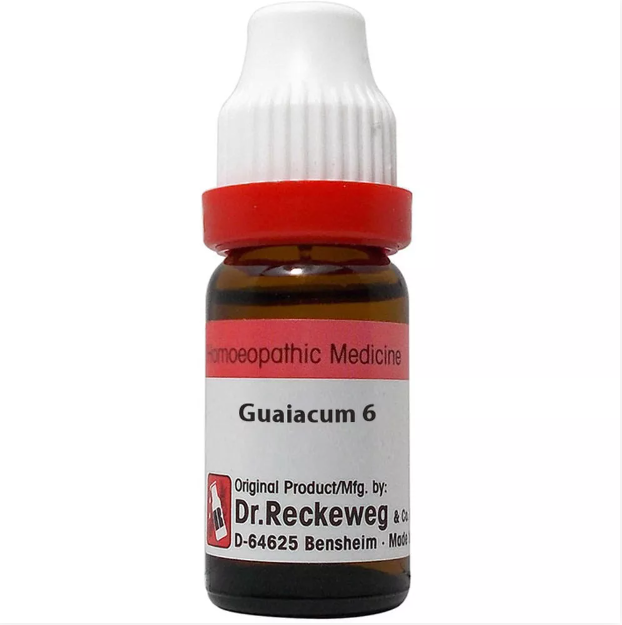GUAIACUM OFFICINALE - GUAJACUM OFFICINALE Q, 6C, 12C, 30C, 200C, 1M, 10M USES AND SYMPTOMS
 GUAIACUM OFFICINALE – GUAJACUM OFFICINALE
GUAIACUM OFFICINALE – GUAJACUM OFFICINALE
(Resin of Lignum Vitae)
Guaj.
Primarily affects fibrous tissue, ideal for arthritis, rheumatism, and tonsillitis. Useful in secondary syphilis and acute rheumatism. Clears foul secretions and unpleasant body odor. Aids abscess suppuration. Sensitive to and worsened by local heat. Causes limb contraction, stiffness, and immobility, with a need to stretch.
Mind: Forgetful, thoughtless, staring, slow comprehension.
Head: Gouty, rheumatic pain in head, face, neck. Tearing skull pain, worse in cold, wet weather. Swollen feeling, distended blood vessels. Left ear ache. Pains ending in a stitch, especially in the head.
Eyes: Dilated pupils, short eyelids, pimples around eyes.
Throat: Rheumatic sore throat, weak muscles, dry, burning, swollen throat, stitches towards ear. Acute tonsillitis, syphilitic sore throat.
Stomach: Furred tongue, craving apples and fruits, aversion to milk. Burning stomach, constricted epigastric region (hyperchlorhydria).
Abdomen: Intestinal fermentation, excessive bowel flatus, diarrhea, cholera infantum.
Urinary: Sharp stitches after urination, constant desire.
Female: Ovaritis in rheumatic patients, irregular menses, dysmenorrhea, irritable bladder (cystitis).
Respiratory: Suffocation (asthma), dry, tight cough, halitosis after coughing, pleuritic stitches, rib joint pain, shortness of breath until expectoration.
Back: Pain from head to neck, aching nape, stiff neck, sore shoulders (cervical spondylosis), stitches between scapulae and occiput, contractive scapular pain.
Extremities: Rheumatic pain in shoulders, arms, hands, growing pains (Ph-ac.), pricking in nates, sciatica, lumbago, gouty tearing, contractions, immovable stiffness, ankle pain extending up leg, lameness, swollen joints, pain intolerant to pressure, heat, stinging limb pain, arthritic lancinations, limb contraction, heat sensation in affected limbs.
Modalities: Worse with motion, heat, cold wet weather, pressure, touch, from 6 p.m. to 4 a.m. Better with external pressure.
Relationship: Guajacolum (for gonorrheal epididymitis, 2 parts to 30 vaseline, locally).
Antidote: Nux-v
Follows: Sep.
Compare: Merc., Caust., Rhus-t., Mez., Rhod.
Dose: Tincture to sixth attenuation.
SYMPTOMS OF GUAIACUM OFFICINALE - GUAJACUM OFFICINALE
Mind:
Forgetful
Thoughtless
Staring
Slow comprehension
Head:
Gouty, rheumatic pain in head, face, neck
Tearing pain in the skull, worse in cold, wet weather
Swollen feeling, distended blood vessels
Aching in the left ear
Pains ending in a stitch, especially in the head
Eyes:
Dilated pupils
Eyelids appear too short
Pimples around eyes
Throat:
Rheumatic sore throat
Weak throat muscles
Dry, burning, swollen throat
Stitches towards ear
Acute tonsillitis
Syphilitic sore throat
Stomach:
Furred tongue
Desire for apples and other fruits
Aversion to milk
Burning in the stomach
Constricted epigastric region (hyperchlorhydria)
Abdomen:
Intestinal fermentation
Excessive flatus in bowels
Diarrhea, cholera infantum
Urinary:
Sharp stitches after urination
Constant desire to urinate
Female:
Ovaritis in rheumatic patients
Irregular menses
Dysmenorrhea
Irritable bladder (cystitis)
Respiratory:
Feels suffocated (asthma)
Dry, tight cough
Halitosis after coughing
Pleuritic stitches
Rib joint pain, shortness of breath until expectoration
Back:
Pain from head to neck
Aching in the nape
Stiff neck and sore shoulders (cervical spondylosis)
Stitches between scapulae and occiput
Contractive pain between scapulae
Extremities:
Rheumatic pain in shoulders, arms, hands
Growing pains (Ph-ac.)
Pricking in the nates
Sciatica, lumbago
Gouty tearing with contractions
Immovable stiffness
Pain in ankles, extending up the leg, causing lameness
Swollen, painful joints, intolerant to pressure and heat
Stinging pain in limbs
Arthritic lancinations followed by limb contraction
Sensation of heat in affected limbs
Modalities:
Worse from motion, heat, cold wet weather, pressure, touch, from 6 p.m. to 4 a.m.
Better with external pressure
selection of the potency
Individualization:
- Homeopathy is based on the principle of treating the individual, not just the disease. The unique symptoms and characteristics of the person are crucial in determining the most suitable potency.
Intensity of Symptoms:
- The intensity of the symptoms guides the choice of potency. If the symptoms are intense and acute, a lower potency (e.g., 6C, 30C) might be considered. For chronic conditions with less intensity, higher potencies (e.g., 200C, 1M) may be appropriate.
Sensitivity of the Patient:
- Some individuals are more sensitive to homeopathic remedies, while others may require higher potencies. The practitioner considers the patient’s sensitivity when selecting the potency.
Acute vs. Chronic Conditions:
- Lower potencies are often used for acute conditions, while higher potencies may be considered for chronic or long-standing issues.
Previous Response to Potencies:
- The patient’s response to previous homeopathic treatments helps guide the choice of potency. If a particular potency has been effective in the past, it may be repeated or adjusted as needed.
Vital Force and Susceptibility:
- Homeopathy views illness as a disturbance in the vital force. The practitioner assesses the patient’s overall vitality and susceptibility to determine the appropriate potency.
Aggravation or Amelioration:
- The direction of the symptom response (aggravation or amelioration) after taking a remedy can influence the choice of potency.
Miasmatic Considerations:
- In classical homeopathy, the concept of miasms (inherited disease tendencies) is considered. The practitioner take this into account when selecting the potency.
Practitioner Experience:
- The experience and preference of the homeopathic practitioner play a role. Some practitioners may have success with certain potencies based on their clinical experience.
SAFETY INFORMATION
- Do not exceed the recommended dose by physician
- Keep out of the reach of children
- Store in a cool dry place away from direct sunlight
- Maintain half an hour gap between food/drink/any other medicines and homoeopathic medicine
- Avoid any strong smell in the mouth while taking medicine e.g. camphor, garlic, onion, coffee, hing
Medicine images use for reference only selection of homeopathic medicine depends on the individual’s specific symptoms and overall constitution. Moreover, homeopathy is a holistic system of medicine that treats the individual as a whole. In addition to addressing the physical symptoms, it takes into account the emotional and mental state of the person. Consequently, it’s crucial to consult with a qualified homeopathic practitioner for personalized treatment.
The information provided on this website is intended solely for educational purposes. Always seek the advice of your physician or other qualified health provider.
